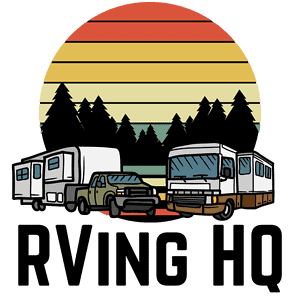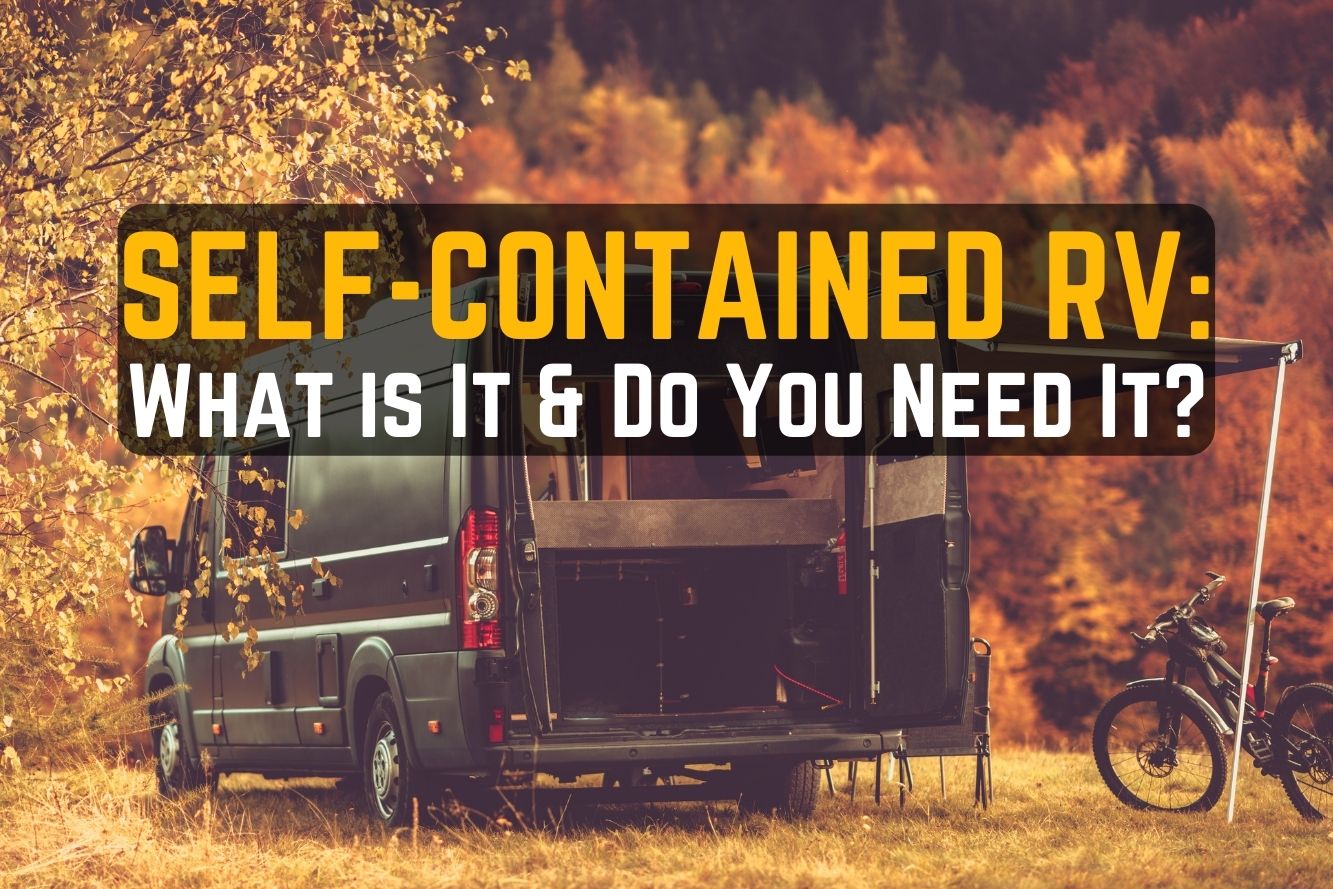‘Self-contained RV’ isn’t a phrase you hear very often in real life, but it is one worth looking at. It’s something we mention frequently on RVing Headquarters and we wanted to provide further insight through this post. So what does self-contained RV mean?
Is it important? Do you need one? Let’s take a closer look.
Table of Contents
What is a Self-Contained RV?
The literal definition of “self-contained” according to Dictionary.com is:
“Containing in oneself all that is necessary; independent.”
And that definition is pretty spot on for RVs, too.
A self-contained RV is an RV that has the ability to be fully self-sufficient. These RVs have plumbing, fresh and waste water storage, a way to cook, and a toilet or full bathroom.
There are many different types of RVs, but any of them can be self-contained.
Some campgrounds will only allow self contained RVs. If you ever see this rule, it means that your camper needs to have a toilet, fresh and waste water holding tanks, and a way to cook inside.
Sometimes, self-contained can also mean the ability to generate your own power, like with solar or a generator. But most often it is just referring to plumbing and cooking. Showering in your RV is another benefit of having a self-contained RV, but not all of them have showers.
In general, a self-contained RV has:
- A fresh water supply.
- A grey water holding tank.
- A black water holding tank.
- A sink or sinks.
- A toilet.
- A cooking area.
If your camper isn’t currently self-contained, don’t worry: you can DIY it! We’ll cover that later in this post.
Is Every RV Self-Contained?
Not every RV is self contained!
There are RVs manufactured that are not self-contained, because not everyone needs or wants a self-contained RV.
Having everything you need onboard is really only important if you are living in your RV or want to camp and travel for extended periods of time.
And even then, some people get along just fine without creature comforts like an onboard toilet or shower.
Almost all large travel trailers, fifth wheels, and motorhomes these days are fully self-contained and have large RV plumbing systems.
The campers that aren’t fully self-contained are campers like small pop ups, hybrid trailers, and some camper vans.
What’s the Smallest Self-Contained RV?
The smallest self-contained RVs and campers are camper vans and even some pop up campers.
Almost any RV can be self-contained. As long as your camper has room to stand up, a surface for cooking, and an area to store a portable camping toilet, it fits the bill!
Can Pop Up Campers be Self-Contained?
Yes, pop up campers can be self-contained. Some pop-up campers are manufactured this way, and other times you can do it yourself.
The canvas tent sides make it harder to regulate temperature in a pop up camper, but you can still carry your own fresh water, dispose of your wastewater, and cook inside of one.
Related: 15 Best Front Kitchen Travel Trailers of All Sizes
How To Make Your Camper Self-Contained, DIY Style
If you want to learn how to make your camper self-contained, you’ll be happy to know that it doesn’t have to be hard OR expensive.
You don’t even have to make alterations to your camper – you can store all of your tanks inside.
At RVHQ, we’ve lived in RVs and have even made our own self-contained camper van, so we know exactly what to do!
Here’s how to make your RV or camper self-contained, DIY style.
1. Fresh Water Storage and Access
First things first: fresh water.
If your RV or camper doesn’t already have some kind of fresh water holding tank or storage system, this one is pretty simple.
You can bring along gallon or 5-gallon jugs of water from the store, or you can create your own DIY sink system.
You can create a simple plumbing system using a 6-gallon jerry can from Wal-Mart for fresh water and another one for grey water.
These jerry cans can be purchased for less than $20 at Wal-Mart in the camping section. They’re relatively thin so they don’t take up a lot of floor space, perfect for small campers.
2. A Sink or a Wash Basin?
How involved or not-involved you make this process is entirely up to you. If you don’t have a sink and you want to install one, it’s definitely not hard!
Otherwise, you can use a collapsible wash basin for everything from washing dishes to catching water from washing your hands, and it stores away easily.
If you’d rather build a simple sink set-up, check out this campervan sink tutorial. It’s so easy that almost anyone can do it.
If you have space, building a sink setup is the most convenient option for the long run.
3. Types of Toilets to Make Your Camper Self-Contained
One of the most crucial components of a self-contained camper is a toilet and a way to store the waste that goes into the toilet.
Luckily, portable camping toilets exist.
Camping toilets start at less than $100 and can cost upwards of $1,000 for composting toilets.
Whichever you choose will depend on your budget, space, and how often you want to deal with dumping it.
The great news is they all store waste easily and odor-free.
Portable camping toilets are small, portable toilets that have a tank on bottom for waste water, a tank on top that holds fresh water for flushing, and a toilet seat.
These toilets cost anywhere from $100+ and typically hold either 2.5 or 5 gallons of wastewater, which needs to be dumped every couple of days.
The top disconnects from the waste tank. The waste tank has a lid and a handle for easy dumping and transport.
Cassette toilets have a similar concept to portable toilets, but they’re much larger and are made to permanently install in your camper. Cassette toilets have a removable tank for dumping and will need to be dumped every few days or once a week, depending on use.
Finally, composting toilets are a great choice. These toilets use a composting medium like soil or coconut coir (husks) to compost solid waste, and a jug that holds liquids.
Composting toilets are more expensive and will require a more in-depth install, but they’re worth it to never have to deal with sewage ever again! The solid waste compartment in a composting toilet only needs to be dumped every 2 weeks or so.
4. Grey Water Storage
Having a self-contained camper means you also need to be able to store your grey water – the dirty water from washing your hands, dishes, etc.
If you decide to build a simple sink area, you can use a jerry can to store your grey water right under the sink.
Alternatively, you can use an empty jug and a funnel to pour dirty water into and store it until you get to a dump station.
5. Cooking in Your Camper
Last but not least, cooking in your camper is key to self-sufficiency.
Most fuel-powered camp stoves are not supposed to be used indoors. However, you can purchase camp stoves that are safe to use inside.
Always remember to ventilate your camper when using fuel-powered cooking sources. Open windows and run your vent fan if you have one.
And if you have enough power, you can always consider an induction cooktop–these are very popular with many RVers.
Where to Dump a Self-Contained Camper
You can dump a self-contained camper anywhere there is an approved RV dumping station.
There are dump stations at some campsites and most campgrounds or RV parks, state parks, some gas stations, RV dealerships, and even at some rest stops.
If you use a composting toilet and only have gray water to dump, you can usually dump gray water down any drain–as long as it doesn’t contain raw sewage.
The waste from a composting toilet can be bagged up and thrown away with regular garbage.
5 Benefits of Having a Self-Contained RV
The benefits of having a self-contained RV are numerous. Once you have everything you need on-board, you’ll never want anything else!
1. Your RV is Fully Self-Sufficient
When your RV is self-contained, it’s fully self-sufficient. You can go anywhere and not need for anything.
You can pull over and use the restroom anywhere you want. Or, you can even pull off and cook a meal while looking out over the ocean even on the most remote parts of a highway.
When you’re self-contained, you’re not reliant on any hook ups to use any of your camper.
2. You Have All The Creature Comforts
It’s so nice to know that you can use the restroom, clean up, AND cook all within the comfort of your own RV or camper.
Cooking outside and trekking to the campground bathroom can be part of the overall camping experience, but that’s not always fun or practical.
Sometimes the weather makes it impossible to cook outside or uncomfortable to walk to the restroom.
And if you’re someone who uses the bathroom several times a night, having a toilet in your camper feels like luxury.
3. Go Anywhere and Stay Longer
A self-contained RV can go to any campsite–whether or not there’s water or sewer hook ups.
And you can stay there longer, too, because you are fully self-sufficient.
4. You Can Live Off-Grid Indefinitely
Being self-contained is essential for boondocking. That’s why so many boondockers love giant fifth-wheel campers!
Fifth wheels are some of the best RVs for boondocking because they have the largest tanks of any other kind of RV.
And if your camper has solar, you really don’t need an expensive campsite.
With a self-contained camper like a fifth wheel, you can boondock indefinitely! All you need to do is head to a dump station when your tanks get full and then head back out there.
5. Some Places Require It!
Some campgrounds and dispersed camping locations are only open to self-contained campers.
So, depending on where you want to camp, it’s a major benefit to have a self-contained RV… because some places won’t allow you without it.
Are There Any Disadvantages?
There really aren’t many disadvantages to having a self-contained RV. In fact, most new and larger RVs come this way and most RVers have learned to expect it!
Here are some potential downsides:
- Water adds additional weight to your RV.
- You have to winterize your RV plumbing system in the winter so the pipes and tanks don’t freeze and crack.
In Conclusion
Most campers and RVs you can buy these days are already fully self-contained.
But, if you want to build a DIY camper van or get (or already have) a small camper, you might need to do it yourself.
There are many benefits of having a self-contained camper, and hardly any cons.
If you’re in the market for a camper or RV, we highly recommend going with one that’s already self-contained. Sure, you can do it yourself, but convenience is better!

